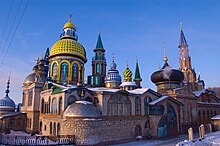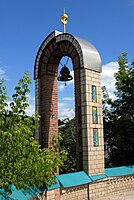Temple of All Religions
| Temple of All Religions Храм всех религий | |
|---|---|
 | |
| Religion | |
| Affiliation | Multiple |
| Location | |
| Location | Staroye Arakchino Microdistrict, Kazan, Russia |
| Geographic coordinates | 55°48′2″N 48°58′30″E / 55.80056°N 48.97500°E |
| Architecture | |
| Architect(s) | Ildar Khanov |
| Style | mixed |
| Groundbreaking | 1992 |
The Temple of All Religions (Russian: Храм всех религий) or the Universal Temple (Russian: Вселенский храм) is an architectural complex in the Staroye Arakchino Microdistrict of Kazan, Russia. It consists of several types of religious architecture including an Orthodox church, a mosque, and a synagogue, among others. It is currently under construction, having been started in 1992 by local artist and philanthropist Ildar Khanov.[1] The structure serves as a cultural center and a residence for Khanov and his assistants.
Khanov is known for his efforts in the treatment of alcoholism, drug addiction, and various other diseases.[1] His former and current patients help him to maintain and develop the Temple, either by direct involvement in the construction work or through sponsorship.
The structure is not an active temple of any one religion, but rather, as Khanov describes its mission, a "temple of culture and truth". It has become a popular landmark in the city of Kazan, which takes pride in the peaceful combination of different cultures (Islamic Tatar culture, Orthodox Russian, and others). The Temple is visited both by tourists and by people seeking Khanov's help.
Khanov says that eventually the structure will have 16 cupolas, corresponding to the 16 major world religions including past religions that are no longer practiced.[2]
Gallery
References
- ^ a b Ракурсы. Творчество Ильдара Ханова at kazan24.ru Template:Ru icon
- ^ /270.htm Temple of the Universe at the Kazan tourist portal Template:Ru icon




